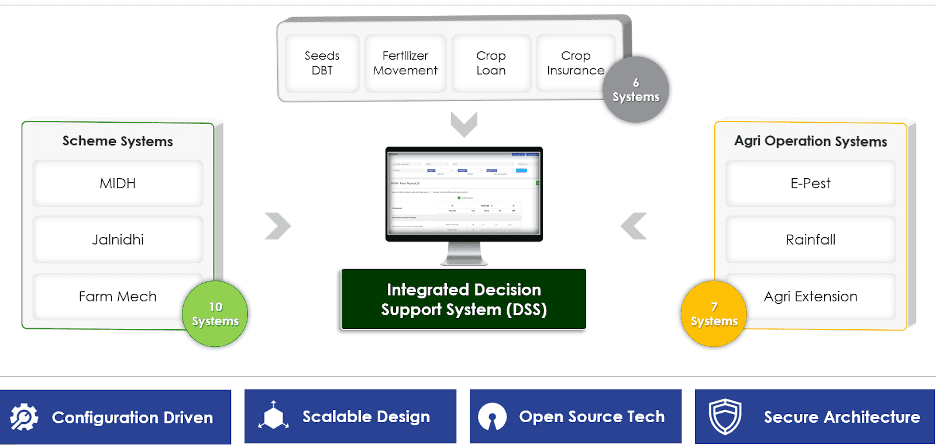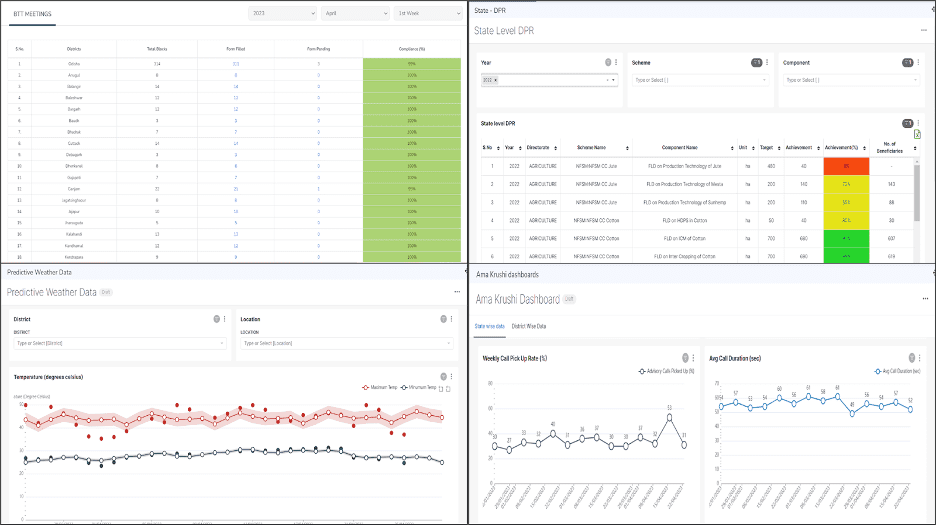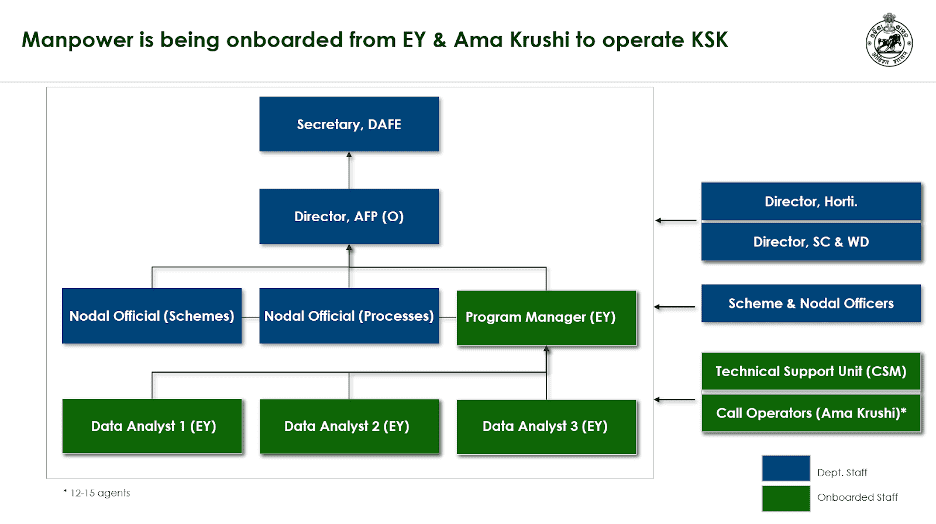How Odisha operationalized India’s 1st Centralized Monitoring System in Agriculture
India was facing one of its most critical public health challenges during the second wave of COVID-19 in May 2021. New Delhi was one of the worst impacted cities during this wave, and as a response, Delhi govt. set up a Centralised Monitoring System to enable real-time data-driven COVID management. Hospitals were directed to provide real-time data surrounding the availability of oxygen, beds, medicine and other medical supplies and equipment. The data was then synthesized in dashboards which were used by senior government officials to drive crucial decisions surrounding the timely provision of scarce medical supplies to severely impacted regions and differential delivery of healthcare to patients based on the severity of their conditions.
Today, data-driven review & monitoring is a key lever of proactive governance. Centralised Monitoring Systems are emerging as replicable models for improving system accountability and service delivery to citizens across domains. Recently, the Ministry of Housing and Urban Affairs has adopted Centralised Monitoring Systems as one of the important pillars of its Smart Cities Mission initiative. Gujarat and Uttar Pradesh have already operationalised Vidya Samiksha Kendras to improve learning outcomes in the public education domain.
Since 2022, the Centralised Monitoring System Model has been implemented in a novel domain, with the Government of Odisha operationalising the Krushi Samiksha Kendra - India's first Centralised Monitoring System for data-driven decision-making in agriculture.
The need for data-backed decision-making in agriculture
Which paddy-growing villages are most at-risk of suffering from severe pest incidence? Do farmers in those villages have timely access to updated plant protection techniques and certified pesticides? Are the govt. field staff assisting farmers adequately?”
These are some of the many complex questions that characterize each day of Rashmi ji’s life, who as a Block Agricultural Officer (BAO) is assigned by the state machinery to support farmers. Rashmi ji is responsible for streamlining the functioning of agricultural operations in a block which impacts about 25,000 farming families directly and affects the economic activity of an entire ecosystem. Rashmi ji is also responsible for overseeing a team of more than a dozen extension workers operating in 15-20 Gram Panchayats (GPs) and coordinating with other government departments to ensure convergence of activities.
Agricultural operations are diverse and complex, they include the provision of inputs, irrigation, implements (such as farm machinery), credit, insurance, schemes and market linkages to farmers in addition to management of environmental disruptions that contribute to crop loss. Overseeing these operations in one block is a mammoth task for officials like Rashmi Ji. Now as a single individual, it is virtually impossible for Rashmi Ji to have clarity on all these fronts on a daily basis and simultaneously implement solutions. To ensure that officials use their domain expertise optimally and make informed, inclusive, and impactful decisions, it is important to equip them with synthesized and analysed data surrounding on-ground realities.
ADAPT Decision Support System
ADAPT (Analytics for Decision Making and Agricultural Policy Transformation) started as a partnership between the Government of Odisha, the Bill & Melinda Gates Foundation and Samagra in 2017 to embed a culture of data-backed decision-making within the Department of Agriculture & Farmers’ Empowerment. It focused on the development of the Decision Support System (DSS) - a system that enables monitoring of agricultural operations, recording of scheme achievement and compliance to processes, and identification of issues being faced by a farmer. This system allows Rashmi ji to monitor all activities impacting farmers in her block, for example: she can now check which gram panchayats in her block are meeting the scheme achievement targets and identify regions where farmers are struggling to avail govt. schemes & subsidies.
ADAPT DSS functions as a unified portal that enables decentralised review & monitoring
More than 5000 officials like Rashmi Ji (from the GP to the state level) have been equipped with ADAPT DSS that enables real-time review & monitoring and informed decision-making surrounding diverse agri-operations. This has been a contributing factor in several key successes of the Government of Odisha including Krushak Assistance for Livelihood and Income Augmentation (KALIA) - India's first direct income transfer scheme, improvement of food-grain production, and implementation of the Hon’ble Chief Minister Naveen Patnaik’s 5T Transformation charter (through interventions like e-pest management).
However, technology by itself, even with the most user-centric design is not consumable by government machinery and is limited in its potential to create sustainable transformation. Critical supplements to this process have been found to include formalised processes, sustained support from manpower with technical expertise, and a system of communication and escalation across the government’s bureaucratic hierarchy. For example, in addition to providing officials at all levels of the hierarchy with dashboards surrounding the progress of a government scheme, it is imperative to set up key processes including codified review meetings, systematic nudges and escalations for low-performing units, and a culture of regular data monitoring.
Development of Centralised Monitoring Systems
The challenges induced by COVID-19 required governments across the world to develop and adopt novel approaches to streamlining service delivery and improving the accountability of officials in the face of adversity. These approaches, whilst effective during a pandemic can also be adapted to improve the experience of citizens whilst engaging with any part of the government machinery. One of the most impactful interventions identified was the Centralised Monitoring System, which is a data-driven mechanism that allows governments to track service delivery, process compliance, and citizen engagement in real-time.
Owing to the success of this model during COVID-19, different departments and ministries from the central and state governments in India have actively started pushing for this approach. These developments at the national level, presented the Department of Agriculture & Farmers’ Empowerment, Government of Odisha, with an ideal opportunity - combining the decentralised monitoring & observability enabled by the ADAPT Decision Support System with a centralised monitoring system to establish and embed a robust culture of data-backed decision making, review and monitoring, and accountability to form the Krushi Samiksha Kendra.
Building a Samiksha Kendra in Agriculture
Work on Krushi Samiksha Kendra, started in April 2022. Whilst constructing a physical monitoring centre from scratch is nothing short of a mammoth task, initial focus rested more on achieving tangible outcomes through such a mechanism within the department (irrespective of the size of video walls and the general pizzazz that surrounds such a structure). A structured approach was formulated for the same:
1. Identifying impactful use-cases and tangible Key Performance Indicators (KPIs): ‘Agri-operations’ is a broad term consisting of different activities that differentially impact farmers’ well-being. As a first step, the extent to which Krushi Samiksha Kendra will be involved in each of the agri-operations and relevant metrics (KPIs) to track their progress was finalised. At a broad level, 3 impactful use-cases were identified for the initial phase of implementation, targeted action along which would empirically have a positive and direct impact on productivity and farmers income:
- Program Implementation: Delivery of schemes (eg: subsidy on purchase of agri inputs like seeds & nutrients, crop demonstration) & services (eg: extension, low-cost crop loans) provided by the government
- Plant Protection: Coordinating relief in case of environmental emergencies (e.g. weather disruption, pest incidence) that causes crop loss
- Policy reform: Improvement of department initiatives basis feedback of stakeholders in the ecosystem
2. Revamping ADAPT DSS as a unified portal for review & monitoring: Over the past few years, the Government of Odisha has operationalised multiple key tech-centric initiatives (such as farmer-facing scheme portal - GO-SUGAM). To ensure that officials on the ground have access to all relevant data points on a unified portal in real-time, a rigorous exercise surrounding API integrations was undertaken. Different actors at the state and national level were aligned to fetch all relevant data points onto ADAPT DSS.
Interactive dashboards used by officials to monitor relevant KPIs
3. Enabling a system of nudges and escalations: Basis the KPIs visible on the ADAPT DSS, department officials get automated and manual nudges and alerts through WhatsApp, call, and email. Regular touchpoints with underperforming units (be it GPs, blocks or districts) allows the state to pre-emptively identify issues and enable resolutions. Based on the response of field officials to nudges and performance of KPIs, issues are escalated within the department hierarchy to the senior most officials as per a defined matrix to ensure timely service delivery & farmers’ welfare.
4. Setting up a team at the state level: It is important to bake in sustainability from day 1 to ensure that a set-up as complex as the Krushi Samiksha Kendra is successful in the long run. A team consisting of 4 components was set up:
- Data Analysts who analyse data and provide consumable insights to officials
- Call centre agents who conduct regular surveys as per defined hypothesis
- Nodal officials from the department to manage logistics and coordination
- Tech team to manage maintenance and enhancements of the ADAPT DSS.
This team structure allowed the department to perfectly balance technological proficiencies and domain knowledge - two equally important determinants of impact.
Organisational structure of the Krushi Samiksha Kendra
5. Review & Monitoring Meetings: A monthly top-down cascaded review & a monitoring calendar was implemented through which each department official conducts a review (of subordinates) and is reviewed (by senior officials) along the same defined KPIs in their jurisdiction. This transparent system ensures that all officials take full ownership of operations (manifested in the form of tangible KPIs) and enables streamlined discussions on and escalation of underperforming KPIs and critical issues on the ground.
Glimpses of cascaded monthly review meetings by Horticulture (left) and Agriculture (right) directorates (Apr 2023)
Pilot success and formal inauguration
A temporary setup of the Krushi Samiksha Kendra was operationalised in September 2022 - just in time for delivering services to the department for the Rabi (winter) cropping season. Trust was gradually earned and the government approved the development of the physical setup of the Krushi Samiksha Kendra within a quarter of operationalisation. Upon completion of civil and technological developments, the Krushi Samiksha Kendra was formally inaugurated by the Hon’ble Chief Minister of Odisha Naveen Patnaik on the auspicious occasion of Akshaya Tritiya (23rd April 2023) - to impact farmer’s lives at scale in the critical Kharif ‘23 (summer) cultivation season and beyond.
Since operationalisation, the Krushi Samiksha Kendra has conducted 50+ hypothesis-driven surveys of target groups to inform and enhance dozens of policies and initiatives (such as seed pre-booking and agri-marketing), identified & escalated 35+ instances of pest incidence before they reached critical scale, improved recorded scheme achievement by over ~40% and officials’ attendance in department forums by ~30%, and implemented real-time crop advisory during pest & weather emergencies. Moreover, the Krushi Samiksha Kendra has become an indispensable tool for crop planning, and has been leveraged for driving the planning and implementation of flagship departmental initiatives, including the Mahanadi Delta Rabi Crop Production Program, the Rice Fallow Management Program, and the Nutrition at Doorstep initiatives.
Glimpses of the developed and fully functional Krushi Samiksha Kendra
This blog is part of the Amrit Series, where we bring to you success stories of large scale impact through our work across domains and states. You can learn more about Krushi Samiksha Kendra here.





